Page 310 of 498
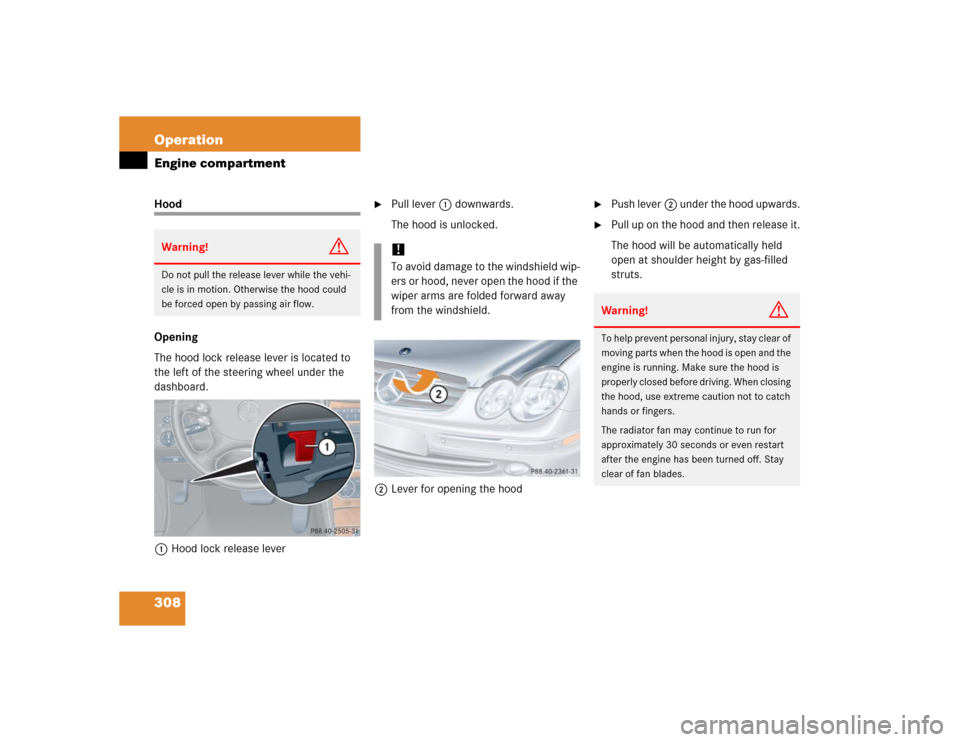
308 OperationEngine compartmentHood
Opening
The hood lock release lever is located to
the left of the steering wheel under the
dashboard.
1Hood lock release lever
�
Pull lever 1 downwards.
The hood is unlocked.
2Lever for opening the hood
�
Push lever2 under the hood upwards.
�
Pull up on the hood and then release it.
The hood will be automatically held
open at shoulder height by gas-filled
struts.
Warning!
G
Do not pull the release lever while the vehi-
cle is in motion. Otherwise the hood could
be forced open by passing air flow.
!To avoid damage to the windshield wip-
ers or hood, never open the hood if the
wiper arms are folded forward away
from the windshield.
Warning!
G
To help prevent personal injury, stay clear of
moving parts when the hood is open and the
engine is running. Make sure the hood is
properly closed before driving. When closing
the hood, use extreme caution not to catch
hands or fingers.
The radiator fan may continue to run for
approximately 30 seconds or even restart
after the engine has been turned off. Stay
clear of fan blades.
Page 311 of 498
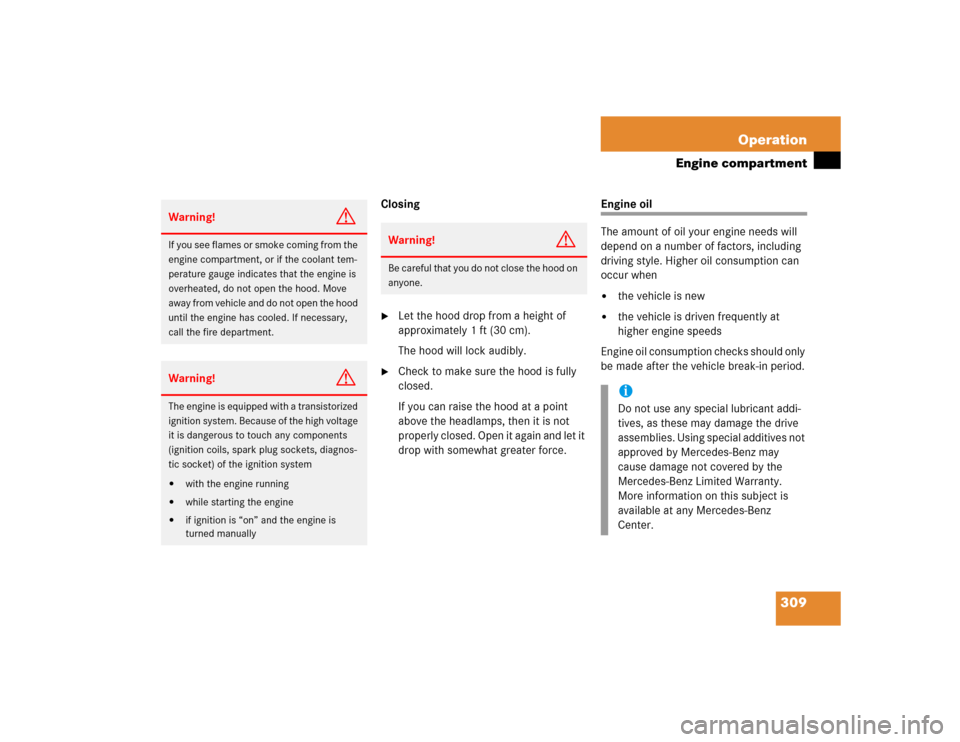
309 Operation
Engine compartment
Closing�
Let the hood drop from a height of
approximately 1 ft (30 cm).
The hood will lock audibly.
�
Check to make sure the hood is fully
closed.
If you can raise the hood at a point
above the headlamps, then it is not
properly closed. Open it again and let it
drop with somewhat greater force.
Engine oil
The amount of oil your engine needs will
depend on a number of factors, including
driving style. Higher oil consumption can
occur when�
the vehicle is new
�
the vehicle is driven frequently at
higher engine speeds
Engine oil consumption checks should only
be made after the vehicle break-in period.
Warning!
G
If you see flames or smoke coming from the
engine compartment, or if the coolant tem-
perature gauge indicates that the engine is
overheated, do not open the hood. Move
away from vehicle and do not open the hood
until the engine has cooled. If necessary,
call the fire department.Warning!
G
The engine is equipped with a transistorized
ignition system. Because of the high voltage
it is dangerous to touch any components
(ignition coils, spark plug sockets, diagnos-
tic socket) of the ignition system�
with the engine running
�
while starting the engine
�
if ignition is “on” and the engine is
turned manually
Warning!
G
Be careful that you do not close the hood on
anyone.
iDo not use any special lubricant addi-
tives, as these may damage the drive
assemblies. Using special additives not
approved by Mercedes-Benz may
cause damage not covered by the
Mercedes-Benz Limited Warranty.
More information on this subject is
available at any Mercedes-Benz
Center.
Page 312 of 498
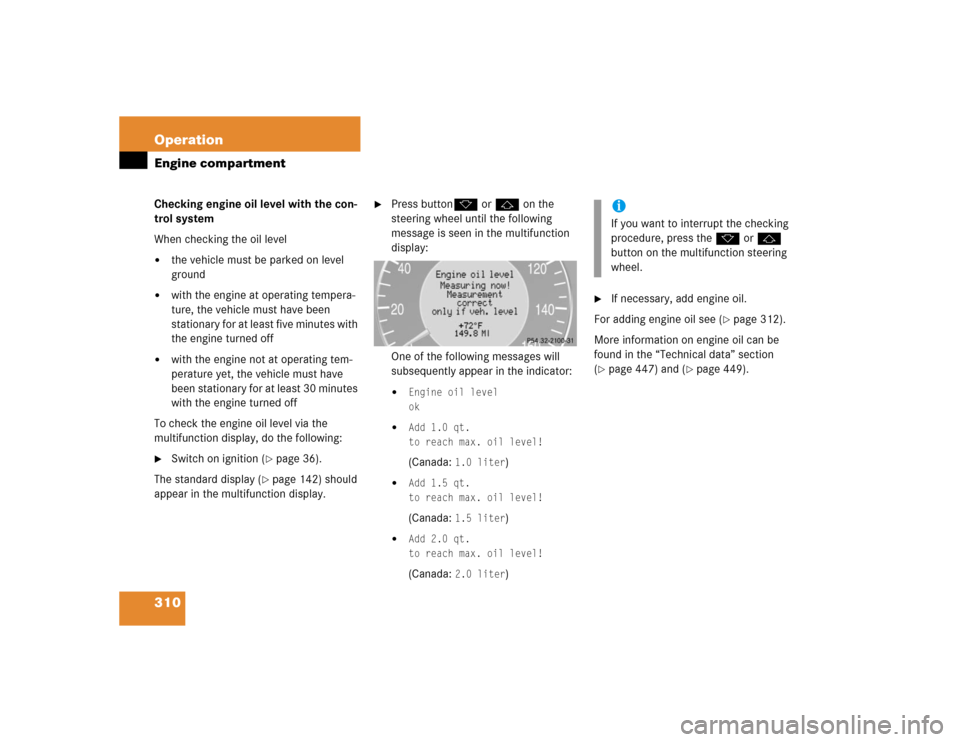
310 OperationEngine compartmentChecking engine oil level with the con-
trol system
When checking the oil level�
the vehicle must be parked on level
ground
�
with the engine at operating tempera-
ture, the vehicle must have been
stationary for at least five minutes with
the engine turned off
�
with the engine not at operating tem-
perature yet, the vehicle must have
been stationary for at least 30 minutes
with the engine turned off
To check the engine oil level via the
multifunction display, do the following:
�
Switch on ignition (
�page 36).
The standard display (
�page 142) should
appear in the multifunction display.
�
Press buttonk or j on the
steering wheel until the following
message is seen in the multifunction
display:
One of the following messages will
subsequently appear in the indicator:�
Engine oil level
ok
�
Add 1.0 qt.
to reach max. oil level!(Canada:
1.0 liter
)
�
Add 1.5 qt.
to reach max. oil level!(Canada:
1.5 liter
)
�
Add 2.0 qt.
to reach max. oil level!(Canada:
2.0 liter
)
�
If necessary, add engine oil.
For adding engine oil see (
�page 312).
More information on engine oil can be
found in the “Technical data” section
(
�page 447) and (
�page 449).
iIf you want to interrupt the checking
procedure, press thek orj
button on the multifunction steering
wheel.
Page 313 of 498

311 Operation
Engine compartment
Other display messages
If the SmartKey is not turned to position2
in the starter switch, the following
message will appear:Turn on ignition
to see engine oil level!�
Switch on the ignition (
�page 36).
If you see the message:
Observe waiting time�
If engine is at operating temperature,
wait five minutes before repeating
check procedure.
�
If engine is not at operating
temperature yet, wait 30 minutes
before repeating check procedure.If you see the message:
Engine oil level
Not when engine on!�
Turn off the engine.
�
If the engine is at operating
temperature, wait five minutes before
checking oil.
�
If the engine is not at operating
temperature yet, you must wait
30 minutes before checking oil.
If there is excess engine oil with the engine
at operating temperature, the following
message will appear:
Engine oil level
Reduce oil level
!
�
Have excess oil siphoned or drained
off. Contact an authorized
Mercedes-Benz Center.More information on messages in the
display concerning engine oil can be found
in the “Practical hints” section
(
�page 379). !Excess oil must be siphoned or drained
off. It could cause damage to the
engine and catalytic converter not
covered by the Mercedes-Benz Limited
Warranty.
Page 314 of 498
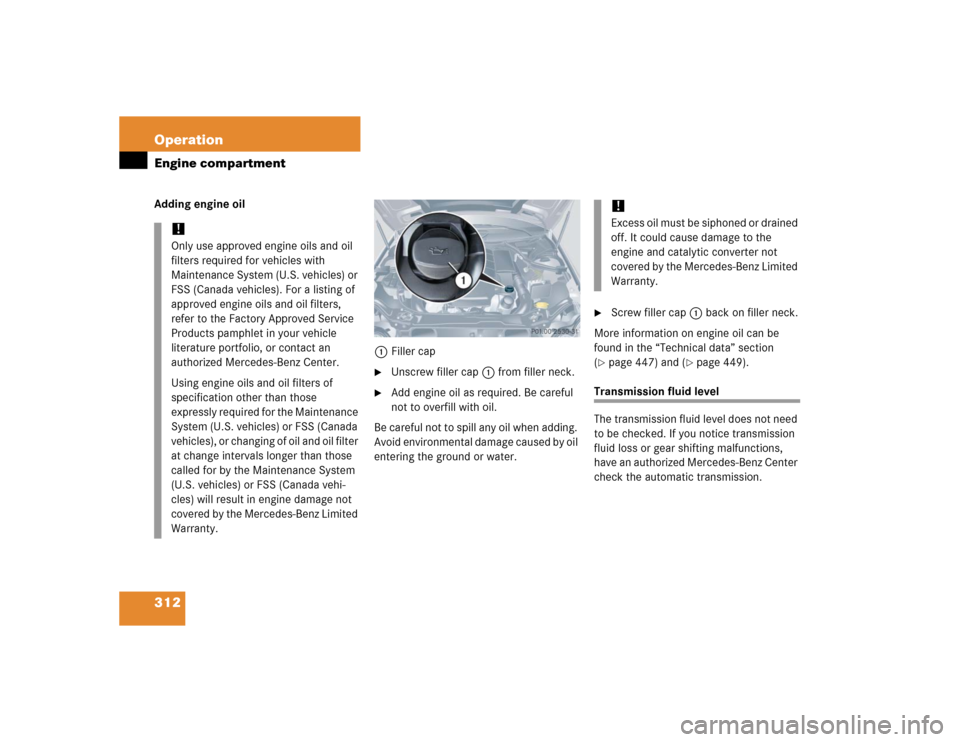
312 OperationEngine compartmentAdding engine oil
1Filler cap
�
Unscrew filler cap1 from filler neck.
�
Add engine oil as required. Be careful
not to overfill with oil.
Be careful not to spill any oil when adding.
Avoid environmental damage caused by oil
entering the ground or water.
�
Screw filler cap1 back on filler neck.
More information on engine oil can be
found in the “Technical data” section
(
�page 447) and (
�page 449).
Transmission fluid level
The transmission fluid level does not need
to be checked. If you notice transmission
fluid loss or gear shifting malfunctions,
have an authorized Mercedes-Benz Center
check the automatic transmission.
!Only use approved engine oils and oil
filters required for vehicles with
Maintenance System (U.S. vehicles) or
FSS (Canada vehicles). For a listing of
approved engine oils and oil filters,
refer to the Factory Approved Service
Products pamphlet in your vehicle
literature portfolio, or contact an
authorized Mercedes-Benz Center.
Using engine oils and oil filters of
specification other than those
expressly required for the Maintenance
System (U.S. vehicles) or FSS (Canada
vehicles), or changing of oil and oil filter
at change intervals longer than those
called for by the Maintenance System
(U.S. vehicles) or FSS (Canada vehi-
cles) will result in engine damage not
covered by the Mercedes-Benz Limited
Warranty.
!Excess oil must be siphoned or drained
off. It could cause damage to the
engine and catalytic converter not
covered by the Mercedes-Benz Limited
Warranty.
Page 315 of 498
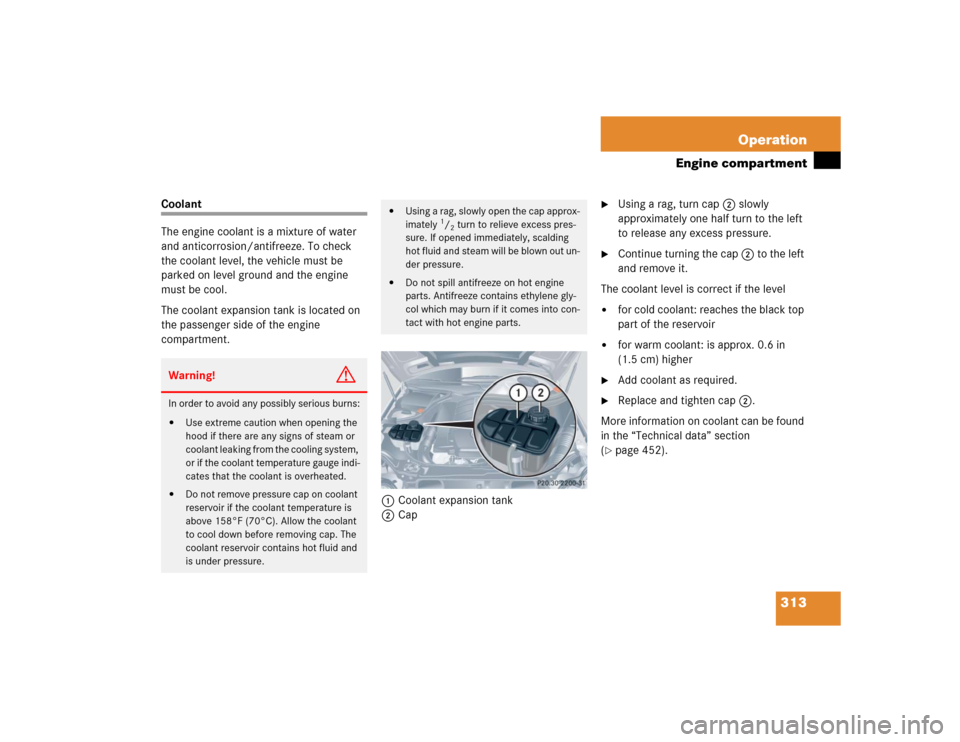
313 Operation
Engine compartment
Coolant
The engine coolant is a mixture of water
and anticorrosion/antifreeze. To check
the coolant level, the vehicle must be
parked on level ground and the engine
must be cool.
The coolant expansion tank is located on
the passenger side of the engine
compartment.
1Coolant expansion tank
2Cap
�
Using a rag, turn cap 2 slowly
approximately one half turn to the left
to release any excess pressure.
�
Continue turning the cap 2 to the left
and remove it.
The coolant level is correct if the level
�
for cold coolant: reaches the black top
part of the reservoir
�
for warm coolant: is approx. 0.6 in
(1.5 cm) higher
�
Add coolant as required.
�
Replace and tighten cap 2.
More information on coolant can be found
in the “Technical data” section
(
�page 452).
Warning!
G
In order to avoid any possibly serious burns:�
Use extreme caution when opening the
hood if there are any signs of steam or
coolant leaking from the cooling system,
or if the coolant temperature gauge indi-
cates that the coolant is overheated.
�
Do not remove pressure cap on coolant
reservoir if the coolant temperature is
above 158°F (70°C). Allow the coolant
to cool down before removing cap. The
coolant reservoir contains hot fluid and
is under pressure.
�
Using a rag, slowly open the cap approx-
imately
1/2 turn to relieve excess pres-
sure. If opened immediately, scalding
hot fluid and steam will be blown out un-
der pressure.
�
Do not spill antifreeze on hot engine
parts. Antifreeze contains ethylene gly-
col which may burn if it comes into con-
tact with hot engine parts.
Page 316 of 498
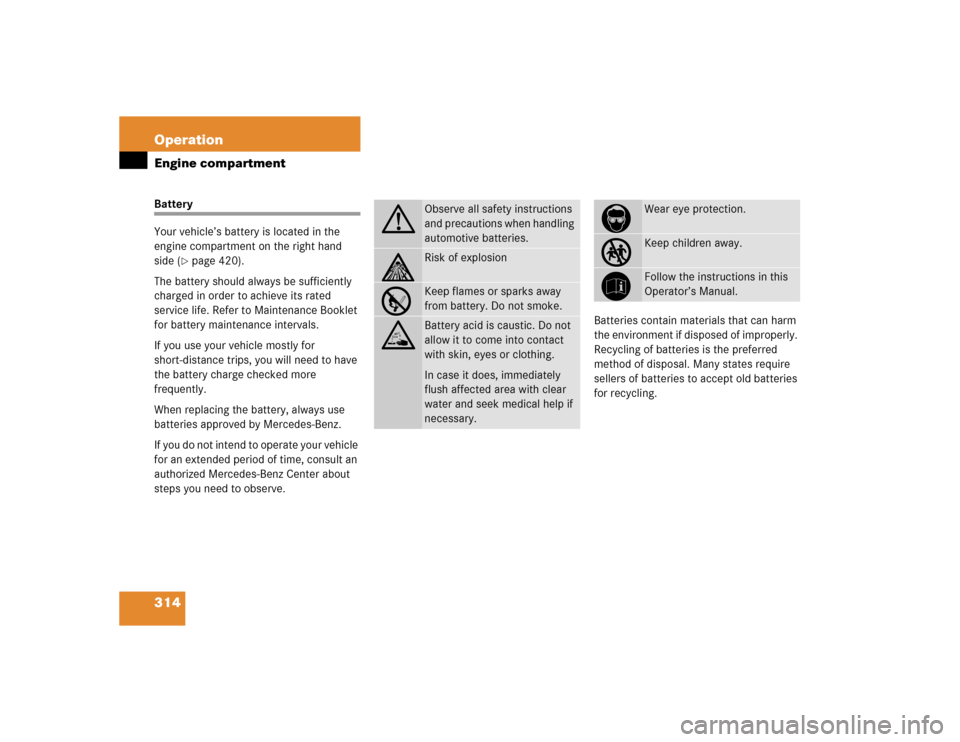
314 OperationEngine compartmentBattery
Your vehicle’s battery is located in the
engine compartment on the right hand
side (
�page 420).
The battery should always be sufficiently
charged in order to achieve its rated
service life. Refer to Maintenance Booklet
for battery maintenance intervals.
If you use your vehicle mostly for
short-distance trips, you will need to have
the battery charge checked more
frequently.
When replacing the battery, always use
batteries approved by Mercedes-Benz.
If you do not intend to operate your vehicle
for an extended period of time, consult an
authorized Mercedes-Benz Center about
steps you need to observe.Batteries contain materials that can harm
the environment if disposed of improperly.
Recycling of batteries is the preferred
method of disposal. Many states require
sellers of batteries to accept old batteries
for recycling.
G
Observe all safety instructions
and precautions when handling
automotive batteries.
A
Risk of explosion
D
Keep flames or sparks away
from battery. Do not smoke.
B
Battery acid is caustic. Do not
allow it to come into contact
with skin, eyes or clothing.
In case it does, immediately
flush affected area with clear
water and seek medical help if
necessary.
E
Wear eye protection.
C
Keep children away.
F
Follow the instructions in this
Operator’s Manual.
Page 317 of 498

315 Operation
Engine compartment
Windshield washer system and headlamp cleaning system*
The windshield washer reservoir is located
in the engine compartment.
1Washer fluid reservoir cap
Fluid for the windshield washer system and
the headlamp cleaning system* is supplied
from the windshield washer reservoir. It
has a capacity of approx. 6.4 US qt (6 l).During all seasons, add MB Windshield
Washer Concentrate “S” to water. Premix
the windshield washer fluid in a suitable
container.
�
Refill the reservoir with MB Windshield
Washer Concentrate “S” and water (or
commercially available premixed wind-
shield washer solvent / antifreeze, de-
pending on ambient temperatures).
Always use washer solvent/antifreeze
where temperatures may fall below the
freezing point. Failure to do so could
result in damage to the washer
system/reservoir.For more information, see “Windshield
washer system and headlamp cleaning
system*” (
�page 454).
!Only use washer fluid which is suitable
for plastic lenses. Improper washer
fluid can damage the plastic lenses of
the headlamps.
Warning!
G
Washer solvent/antifreeze is highly flam-
mable. Do not spill washer
solvent/antifreeze on hot engine parts,
because it may ignite and burn. You could be
seriously burned.